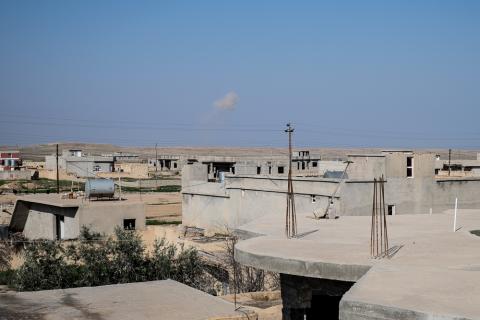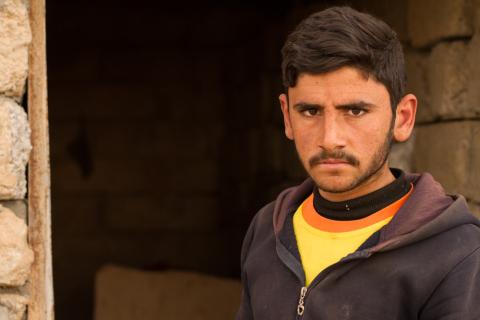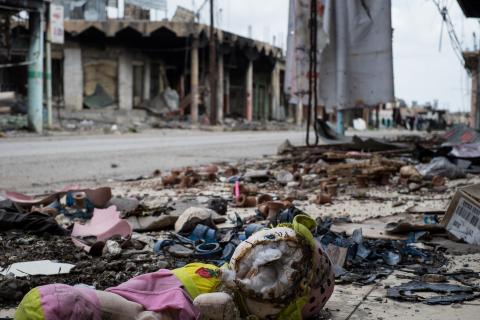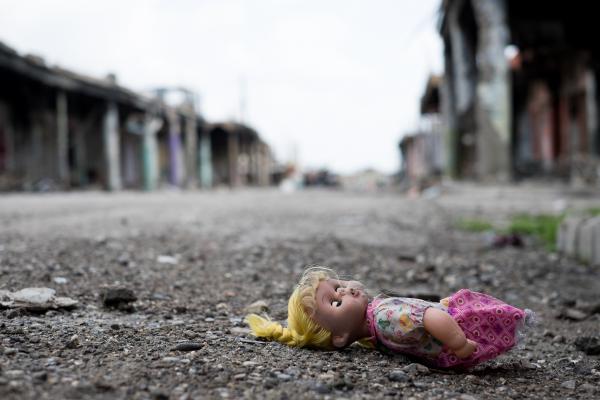We felt the first explosion during breakfast. My hand froze halfway to my mouth, suspended in mid-air holding a piece of bread dipped in yogurt. The walls shook immediately after we heard the distant boom.
My colleague Matt and I looked at each other, surprised expressions on both our faces, then headed to the roof in time to see a cloud rise up on the horizon, just beyond the empty neighborhood.
Matt, who had just left a message for some of our colleagues miles away, recorded a quick update. There was no cell phone coverage or wifi, so it would be hours before the message was delivered.
“Yeah, about five seconds after I stopped talking to you guys, there was an explosion that shook the whole house. And we’re trying to figure out what actually happened. There’s a pretty significant cloud on the edge of the city, though …”
There were more explosions later in the day in Sinjar, closer to the front line with ISIS. More clouds marking impact. Hours passed before we learned the sobering truth:
Many of those clouds carried chemical weapons.
2016.02.25.Sinjar.City_.jpg

Eventually, we returned home, having escaped the tangible effects of the day's warfare. Many militia and civilians in the area were not so lucky. Hospital rooms were filled with those seeking help for burning lungs, eyes, and skin.
"The Islamic State (IS) insurgents have once again used chemical weapons against Kurdish Peshmerga forces in Southern Kirkuk province,” Kurdistan-based BasNews reported. “Several people, including civilians from the area, are reportedly suffering from itching skin and other symptoms of a chemical poisoning.”
The report continued:
Initial investigations have confirmed that ISIS has improvised rockets with chemical substances, specifically mustard gas, to cause greater casualties in its offensivesagainst Peshmerga.
Voice of America added:
Dozens of peshmerga as well as civilians reported suffering from nausea and vomiting after homemade IS rockets hit the area. If confirmed, according to the Kurdish authority it would be the eighth chemical weapon attack on its forces.
Chlorine gas has been used in Syria's civil war for years, but reports of chemical weapons used inside Iraq have been growing in recent weeks. Chlorine gas, mustard gas, and yellow phosphorous have all been discharged — sometimes against military targets, sometimes against civilians. In each case, the attacks leave telltale patterns of burns and physical damage.
It is a worrying addition to the already dark legacy of chemical warfare in Iraq.
March 16 is a somber anniversary in Kurdistan. It marks one of the bleakest days in Saddam Hussein's genocidal war against Kurds in northern Iraq. On that day in 1988, planes dropped bombs on the city of Halabja. The bombs were filled with a lethal cocktail of chemical weapons designed to cause maximum damage.
2016.02.22.Sinjar.jpg

As many as 5,000 people were killed within hours. Anther 7,000 were seriously injured. Generations later, the impact continues to be felt among the city's newborns. Researchers have noted a strong correlation between exposure to chemical agents like mustard gas and the risk of birth defects among children of those exposed. In other words, weapons dropped 28 years ago are still wreaking havoc.
Saddam’s use of chemical weapons against his own people is well known. But Iraq is also contaminated with depleted uranium (DU) from weaponry used during recent wars in Iraq. DU is a waste product from the manufacture of nuclear weapons and reactors, and it can be made into powerful weaponry. The six billion DU bullets spent in Iraq were designed to pierce through armor and ignite on impact.
Though controversial, some allege that exposure to DU is a contributing factor in the high rate of birth defects, cancer, and miscarriage in cities like Basra and Fallujah. A spike was seen in Basra nearly a generation ago, after the first Gulf War in 1991. Following the 2003 invasion, defects spiked in Fallujah, as the amount of DU used in Iraq reached an estimated 2,000 tons.
Iraq is experiencing a national health crisis, especially in cities like Halabja, Fallujah and Basra. Once the violence ceased, most people had no choice but to return to contaminated homes, leaving their families to suffer the consequences for generations.
2016.02.25.Sinjar.City_72.jpg

The defects are often grotesque — and the numbers are astounding. In Fallujah, studies have claimed that up to 14 out of 100 babies are born with a birth defect — a rate considerably higher than that of post-war Hiroshima and Nagasaki. Heart defects are especially common.
For years, we’ve been working to heal the wounds of war, to eradicate the backlog of children waiting for lifesaving heart surgeries. You’ve leaned into the pain and suffering when others have turned away. You’ve stood with Iraq’s children — the “collateral damage” whose value cannot be diminished by the euphemisms of war.
Now we must lean in once more. Otherwise, the use of chemical weapons by groups like ISIS will only extend the cycle of violence and its consequences.
That’s why we continue to press in, working to develop frameworks for lasting peace and cooperation — even as we provide urgent care for those displaced by violence and help survivors overcome the effects of war.
In the end, no chemical weapon is any match for the power of love. So we’ll continue to lean in. We’ll continue to unmake violence though acts of preemptive love. Even as the bombs fall, we’ll pursue peace, one heart at a time.
This article originally appeared at the Preemptive Love Coalition blog. With contributions from Alicia Hughes.
Got something to say about what you're reading? We value your feedback!

